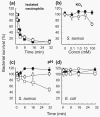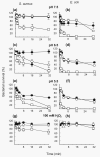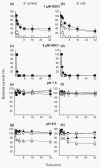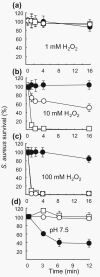Reassessment of the microbicidal activity of reactive oxygen species and hypochlorous acid with reference to the phagocytic vacuole of the neutrophil granulocyte
- PMID: 12867557
- PMCID: PMC2635949
- DOI: 10.1099/jmm.0.05181-0
Reassessment of the microbicidal activity of reactive oxygen species and hypochlorous acid with reference to the phagocytic vacuole of the neutrophil granulocyte
Abstract
During phagocytosis, neutrophils undergo a burst of respiration in which oxygen is reduced to superoxide (O(-)(2)), which dismutates to form H(2)O(2). Myeloperoxidase (MPO) is discharged from the cytoplasmic granules into the phagosome following particle ingestion. It is thought to utilize H(2)O(2) to oxidize halides, which then react with and kill ingested microbes. Recent studies have provided new information as to the concentration of O(-)(2) and proteins, and the pH, within the vacuole. This study was conducted to examine the antimicrobial effect of O(-)(2), H(2)O(2) and hypochlorous acid under these conditions and it was found that the previously described bactericidal effect of these agents was reversed in the presence of granule proteins or MPO. To establish which cellular proteins were iodinated by MPO, cellular proteins and bacterial proteins, iodinated in neutrophils phagocytosing bacteria in the presence of (125)I, were separated by 2D gel electrophoresis. Iodinated spots were detected by autoradiography and the oxidized proteins were identified by MS. The targets of these iodination reactions were largely those of the host cell rather than those of the engulfed microbe.
Figures





Similar articles
-
MCLA-dependent chemiluminescence suggests that singlet oxygen plays a pivotal role in myeloperoxidase-catalysed bactericidal action in neutrophil phagosomes.Luminescence. 2003 Jul-Aug;18(4):229-38. doi: 10.1002/bio.728. Luminescence. 2003. PMID: 12950060
-
Modeling the reactions of superoxide and myeloperoxidase in the neutrophil phagosome: implications for microbial killing.J Biol Chem. 2006 Dec 29;281(52):39860-9. doi: 10.1074/jbc.M605898200. Epub 2006 Oct 30. J Biol Chem. 2006. PMID: 17074761
-
Iodination by stimulated human neutrophils. Studies on its stoichiometry, subcellular localization and relevance to microbial killing.Biochem J. 1983 Jan 15;210(1):215-25. doi: 10.1042/bj2100215. Biochem J. 1983. PMID: 6303312 Free PMC article.
-
Redox reactions and microbial killing in the neutrophil phagosome.Antioxid Redox Signal. 2013 Feb 20;18(6):642-60. doi: 10.1089/ars.2012.4827. Epub 2012 Oct 9. Antioxid Redox Signal. 2013. PMID: 22881869 Review.
-
Myeloperoxidase in human neutrophil host defence.Cell Microbiol. 2014 Aug;16(8):1146-55. doi: 10.1111/cmi.12312. Epub 2014 Jun 19. Cell Microbiol. 2014. PMID: 24844117 Free PMC article. Review.
Cited by
-
The Impact of Hypoxia on the Host-Pathogen Interaction between Neutrophils and Staphylococcus aureus.Int J Mol Sci. 2019 Nov 7;20(22):5561. doi: 10.3390/ijms20225561. Int J Mol Sci. 2019. PMID: 31703398 Free PMC article. Review.
-
The Dual Role of Myeloperoxidase in Immune Response.Int J Mol Sci. 2020 Oct 29;21(21):8057. doi: 10.3390/ijms21218057. Int J Mol Sci. 2020. PMID: 33137905 Free PMC article. Review.
-
Myeloperoxidase: a front-line defender against phagocytosed microorganisms.J Leukoc Biol. 2013 Feb;93(2):185-98. doi: 10.1189/jlb.0712349. Epub 2012 Oct 11. J Leukoc Biol. 2013. PMID: 23066164 Free PMC article. Review.
-
Are reactive oxygen species always detrimental to pathogens?Antioxid Redox Signal. 2014 Feb 20;20(6):1000-37. doi: 10.1089/ars.2013.5447. Epub 2013 Oct 26. Antioxid Redox Signal. 2014. PMID: 23992156 Free PMC article. Review.
-
Phagocytic superoxide specifically damages an extracytoplasmic target to inhibit or kill Salmonella.PLoS One. 2009;4(3):e4975. doi: 10.1371/journal.pone.0004975. Epub 2009 Mar 23. PLoS One. 2009. PMID: 19305502 Free PMC article.
References
Publication types
MeSH terms
Substances
Grants and funding
LinkOut - more resources
Full Text Sources
Molecular Biology Databases
Research Materials
Miscellaneous

